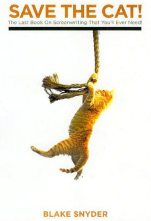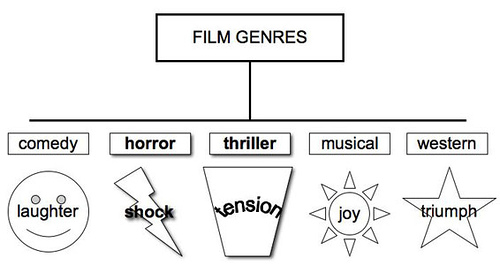In my last two posts I covered a variety of alternative plots that deviate from traditional arch plot. In this post I want to address what is known as a plot genre.
You’ve probably stumbled across craft books that told you there are x-number of plot types and the story you are writing probably falls into one of these catagories. For example Blake Snyder’s Save the Cat offers the following list:
 Monster in the House
Monster in the House- Golden Fleece
- Out of the Bottle
- Dude with a Problem
- Rites of Passage
- Buddy Love
- Whydunit
- The Fool Triumphant
- Institutionalized
- Superhero
Or maybe you’ve stumbled across Ronald Tobias’ 20 Master Plots and How to Build Them, which offers these as plot variations:
 Coming of Age Plot
Coming of Age Plot- Atonement Plot
- Love Plot
- Forbidden Love Plot
- Revenge Plot
- Mystery Plot
- Adventure Plot
- Rescue Plot
- Escape Plot
- Temptation Plot
- You get the picture…
So, why aren’t these alternative plots? Why didn’t I include them in my alternative plot list?
Great question.
This is the difference between what I call a plot type and a plot genre. The list above is a category: romance, mystery, superhero, buddy flick, etc. They all come with conventions and audience expectations. And yes, they sometime even come with what one might call “obligatory scenes” (i.e. a scene you would expect from that genre of story). In my book, however, these are all still variations of the hero’s journey/goal-oriented plot. They don’t push the envelope of plot in a new way. Instead they use the conventions of arch plot to tell this variation of the goal-oriented story. Instead of a quest, it’s the goal to “get the girl” or “seek revenge” or “solve the mystery.” The reason we often hear that there is only “one type of story” is because we often lump everything (including all these genre variations) under the umbrella of a goal-oriented story.
Of course you can take any one of these genres and decide to use an alternative plot! Of course you can! And I’d love to see you do that.
But let’s not get confused. A plot-type is defined by the type of action and it’s cause-and-effect relationships. Whereas a plot-genre is defined by the category of the story-type and the expectations and conventions of that category.



In my last two posts I covered a variety of alternative plots that deviate from traditional arch plot. In this post I want to address what is known as a plot genre.
You’ve probably stumbled across craft books that told you there are x-number of plot types and the story you are writing probably falls into one of these catagories. For example Blake Snyder’s Save the Cat offers the following list:
 Monster in the House
Monster in the House- Golden Fleece
- Out of the Bottle
- Dude with a Problem
- Rites of Passage
- Buddy Love
- Whydunit
- The Fool Triumphant
- Institutionalized
- Superhero
Or maybe you’ve stumbled across Ronald Tobias’ 20 Master Plots and How to Build Them, which offers these as plot variations:
 Coming of Age Plot
Coming of Age Plot- Atonement Plot
- Love Plot
- Forbidden Love Plot
- Revenge Plot
- Mystery Plot
- Adventure Plot
- Rescue Plot
- Escape Plot
- Temptation Plot
- You get the picture…
So, why aren’t these alternative plots? Why didn’t I include them in my alternative plot list?
Great question.
This is the difference between what I call a plot type and a plot genre. The list above is a category: romance, mystery, superhero, buddy flick, etc. They all come with conventions and audience expectations. And yes, they sometime even come with what one might call “obligatory scenes” (i.e. a scene you would expect from that genre of story). In my book, however, these are all still variations of the hero’s journey/goal-oriented plot. They don’t push the envelope of plot in a new way. Instead they use the conventions of arch plot to tell this variation of the goal-oriented story. Instead of a quest, it’s the goal to “get the girl” or “seek revenge” or “solve the mystery.” The reason we often hear that there is only “one type of story” is because we often lump everything (including all these genre variations) under the umbrella of a goal-oriented story.
Of course you can take any one of these genres and decide to use an alternative plot! Of course you can! And I’d love to see you do that.
But let’s not get confused. A plot-type is defined by the type of action and it’s cause-and-effect relationships. Whereas a plot-genre is defined by the category of the story-type and the expectations and conventions of that category.



 Monster in the House
Monster in the House Coming of Age Plot
Coming of Age Plot



Ingrid – I have to thank you for your marvelous plot posts. I have learned so much! Your descriptions have helped me think more clearly about my writing, and I refer to them often!
These posts on plot have been great. Thank you for encouraging people to break out of the goal-oriented plot and think about other ways of constructing their book.
I need to bookmark this post, because this is GREAT info!!! I have a question though: are alternative plots better for certain age levels? For example, have you seen a MG book with an alternative plot?
L. Marie – some might argue that alternative plots could be better received by younger audiences because they have had less exposure to arch plot and don’t find it as “uncomfortable” when they are presented with an alternative plot.
And, yes, there are MG books with alternative plots. The first that comes to mind is “Criss Cross” by Lynne Rae Perkins (which also won the Newbery).
I’m so glad to hear they’ve been helpful!